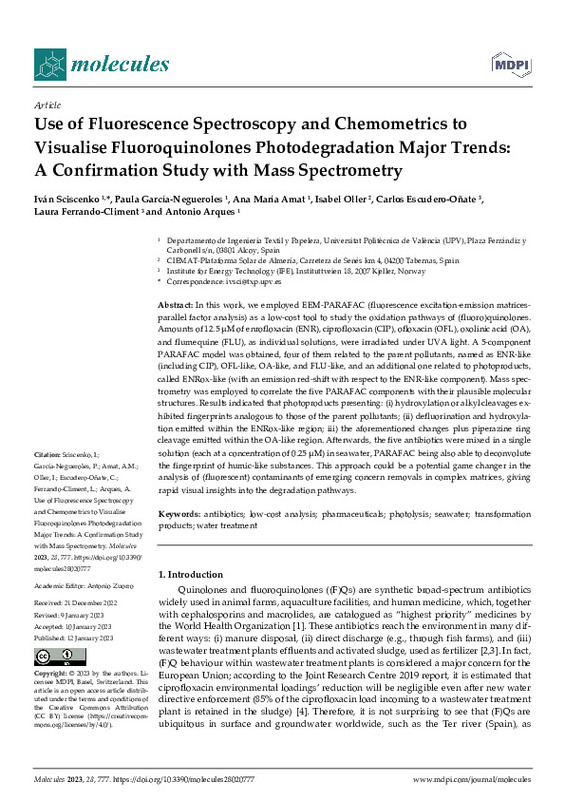JavaScript is disabled for your browser. Some features of this site may not work without it.
Buscar en RiuNet
Listar
Mi cuenta
Estadísticas
Ayuda RiuNet
Admin. UPV
Use of Fluorescence Spectroscopy and Chemometrics to Visualise Fluoroquinolones Photodegradation Major Trends: A Confirmation Study with Mass Spectrometry
Mostrar el registro sencillo del ítem
Ficheros en el ítem
| dc.contributor.author | Sciscenko, Iván Matías
|
es_ES |
| dc.contributor.author | García-Negueroles, Paula
|
es_ES |
| dc.contributor.author | Amat Payá, Ana María
|
es_ES |
| dc.contributor.author | Oller, Isabel
|
es_ES |
| dc.contributor.author | Escudero-Oñate, Carlos
|
es_ES |
| dc.contributor.author | Ferrando-Climent, Laura
|
es_ES |
| dc.contributor.author | Arqués Sanz, Antonio
|
es_ES |
| dc.date.accessioned | 2024-02-28T19:04:49Z | |
| dc.date.available | 2024-02-28T19:04:49Z | |
| dc.date.issued | 2023-01 | es_ES |
| dc.identifier.uri | http://hdl.handle.net/10251/202842 | |
| dc.description.abstract | [EN] In this work, we employed EEM-PARAFAC (fluorescence excitation-emission matrices-parallel factor analysis) as a low-cost tool to study the oxidation pathways of (fluoro)quinolones. Amounts of 12.5 ¿M of enrofloxacin (ENR), ciprofloxacin (CIP), ofloxacin (OFL), oxolinic acid (OA), and flumequine (FLU), as individual solutions, were irradiated under UVA light. A 5-component PARAFAC model was obtained, four of them related to the parent pollutants, named as ENR-like (including CIP), OFL-like, OA-like, and FLU-like, and an additional one related to photoproducts, called ENRox-like (with an emission red-shift with respect to the ENR-like component). Mass spectrometry was employed to correlate the five PARAFAC components with their plausible molecular structures. Results indicated that photoproducts presenting: (i) hydroxylation or alkyl cleavages exhibited fingerprints analogous to those of the parent pollutants; (ii) defluorination and hydroxylation emitted within the ENRox-like region; (iii) the aforementioned changes plus piperazine ring cleavage emitted within the OA-like region. Afterwards, the five antibiotics were mixed in a single solution (each at a concentration of 0.25 ¿M) in seawater, PARAFAC being also able to deconvolute the fingerprint of humic-like substances. This approach could be a potential game changer in the analysis of (fluorescent) contaminants of emerging concern removals in complex matrices, giving rapid visual insights into the degradation pathways. | es_ES |
| dc.description.sponsorship | This work is part of a project that received funding from the European Union's Horizon 2020 research and innovation programme under the Marie Sklodowska-Curie grant agreement No. 765860 (AQUAlity). The paper reflects only the authors' view and the Agency is not responsible for any use that may be made of the information it contains. The authors also wish to thank the Spanish Ministry of Science and Innovation (MCI) for funding under the AquaEnAgri Project (Reference: PID2021-126400OB-C31). Further thanks goes to the Water JPI-Biodiversa COFUND Program for funding the BIORESET project and supporting the research of the scientist Laura Ferrando Climent. | es_ES |
| dc.language | Inglés | es_ES |
| dc.publisher | MDPI AG | es_ES |
| dc.relation.ispartof | Molecules | es_ES |
| dc.rights | Reconocimiento (by) | es_ES |
| dc.subject | Antibiotics | es_ES |
| dc.subject | Low-cost analysis | es_ES |
| dc.subject | Pharmaceuticals | es_ES |
| dc.subject | Photolysis | es_ES |
| dc.subject | Seawater | es_ES |
| dc.subject | Transformation products | es_ES |
| dc.subject | Water treatments | es_ES |
| dc.subject.classification | QUIMICA FISICA | es_ES |
| dc.title | Use of Fluorescence Spectroscopy and Chemometrics to Visualise Fluoroquinolones Photodegradation Major Trends: A Confirmation Study with Mass Spectrometry | es_ES |
| dc.type | Artículo | es_ES |
| dc.identifier.doi | 10.3390/molecules28020777 | es_ES |
| dc.relation.projectID | info:eu-repo/grantAgreement/AEI/Plan Estatal de Investigación Científica y Técnica y de Innovación 2021-2023/PID2021-126400OB-C31/ES/REVALORIZACION DE DIFERENTES AGUAS RESIDUALES MEDIANTE TECNOLOGIAS QUE PERMITAN MEJORAR EL NEXO AGUA-ENERGIA RENOVABLE-ALIMENTOS/ | es_ES |
| dc.relation.projectID | info:eu-repo/grantAgreement/EC/H2020/765860/EU | es_ES |
| dc.rights.accessRights | Abierto | es_ES |
| dc.contributor.affiliation | Universitat Politècnica de València. Departamento de Ingeniería Textil y Papelera - Departament d'Enginyeria Tèxtil i Paperera | es_ES |
| dc.contributor.affiliation | Universitat Politècnica de València. Escuela Politécnica Superior de Alcoy - Escola Politècnica Superior d'Alcoi | es_ES |
| dc.description.bibliographicCitation | Sciscenko, IM.; García-Negueroles, P.; Amat Payá, AM.; Oller, I.; Escudero-Oñate, C.; Ferrando-Climent, L.; Arqués Sanz, A. (2023). Use of Fluorescence Spectroscopy and Chemometrics to Visualise Fluoroquinolones Photodegradation Major Trends: A Confirmation Study with Mass Spectrometry. Molecules. 28(2). https://doi.org/10.3390/molecules28020777 | es_ES |
| dc.description.accrualMethod | S | es_ES |
| dc.relation.publisherversion | https://doi.org/10.3390/molecules28020777 | es_ES |
| dc.type.version | info:eu-repo/semantics/publishedVersion | es_ES |
| dc.description.volume | 28 | es_ES |
| dc.description.issue | 2 | es_ES |
| dc.identifier.eissn | 1420-3049 | es_ES |
| dc.identifier.pmid | 36677831 | es_ES |
| dc.identifier.pmcid | PMC9864895 | es_ES |
| dc.relation.pasarela | S\482483 | es_ES |
| dc.contributor.funder | AGENCIA ESTATAL DE INVESTIGACION | es_ES |
| dc.contributor.funder | COMISION DE LAS COMUNIDADES EUROPEA | es_ES |








